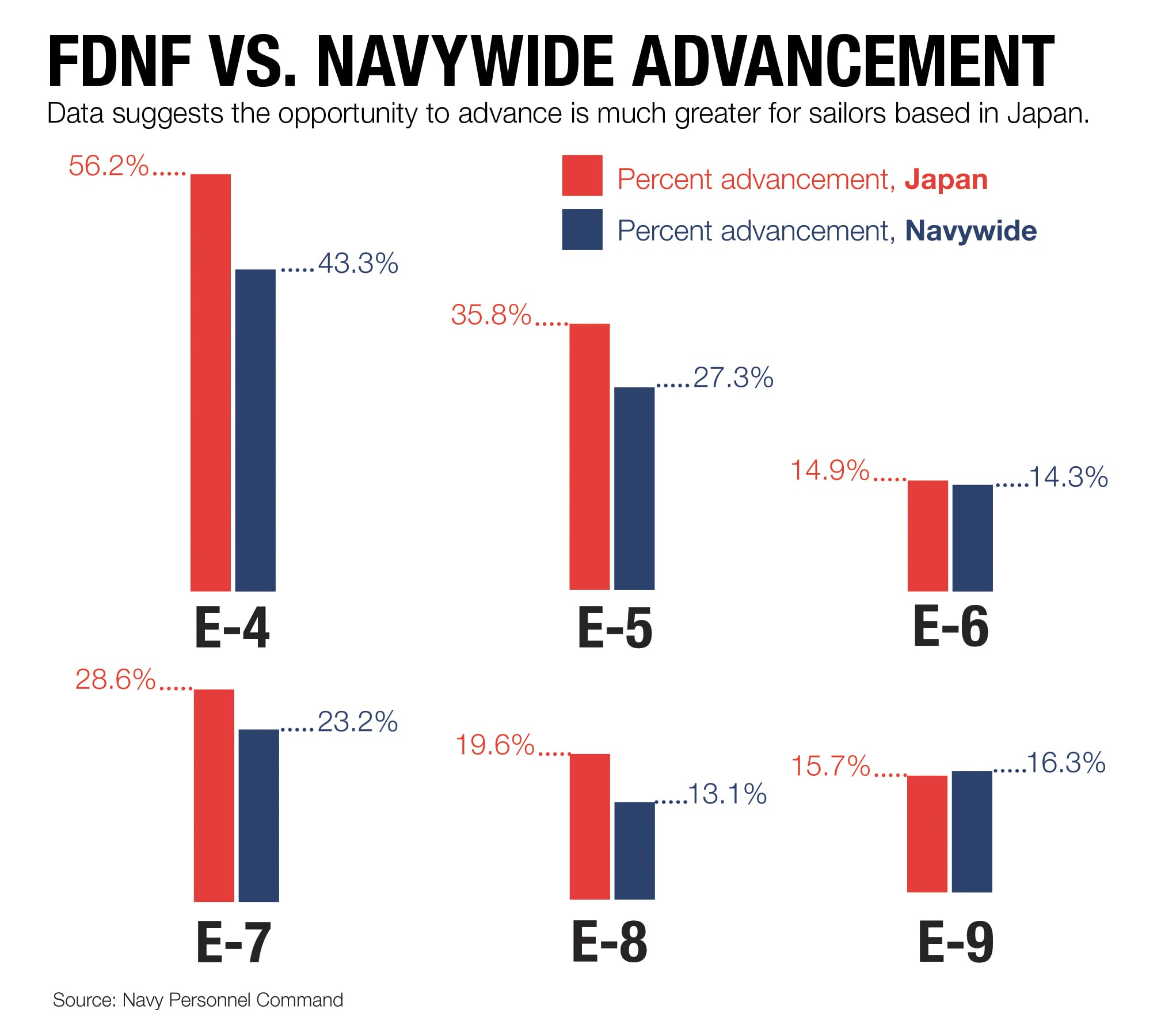Sailors looking for an advantage in the advancement arena might want to look to the Pacific when picking their next duty station.
Despite a year of fatal mishaps for the Navy’s 7th Fleet, an indisputable fact of life for the Japan-based Forward Deployed Naval Forces is that sailors operate on different deployment schedules compared to their stateside peers.
This higher operational tempo translates to greater in-rating knowledge as sailors perform in more real-world situations.
And it appears to lead to better advancement chances among those enlisted sailors.
Navy personnel data suggests that forward-deployed sailors in Japan advance at a higher rate than the rest of the Navy.
For example, this year, the advantage was most dramatic for sailors moving into the E-4 paygrades, where FDNF sailors’ advancement rate was 56 percent, 13 points higher than the 43 percent Navy-wide, according to data provided by the Chief of Naval Personnel.
The gap likely reflects the arduous life in 7th Fleet. Deploying more often gives sailors a better understanding of their rate, “improving their propensity of having a higher exam score, which translates into a higher Final Multiple Score for advancement,” said Capt. Amy Derrick, special assistant for the Chief of Naval Personnel.
“These higher advancements are a testament to the subject matter expertise that is being developed in sailors assigned to FDNF Japan units.”
Why forward-deployed sailors get this boost is directly related to training FDNF units receive, according Bill Hatch, a retired Navy commander who now teaches manpower analysis and policy at the Naval Postgraduate School in California.
For both officer and enlisted sailors, FDNF duty can take standard knowledge to an advanced level, Hatch said.
“I was told by one of my commanding officers that if you want to be operational and really understand how the Navy works then you need to do your department head tour on a ship in Japan and he was right,” Hatch said. “I learned far more being forward-deployed than being stationed on a ship in Hawaii, San Diego or Norfolk.”
“It’s a different deployment concept where often you tend to spend a ton of time operating away from your home port and in three- or four-month stints,” Hatch said. “The more time you are at sea, the more time you have to practice your rating and train as a crew.”
This should, in theory, give FDNF sailors an edge when taking tests, which “make up the largest piece of the advancement puzzle,” he said.
But there’s more factors giving sailors in the FDNF a significant advantage when it comes to advancement.
“You also get advancement credit for other things, such as awards, letters of commendations … recognition for operational accomplishments, and I think those things occur at a higher rate” in the FDNF, Hatch said.
That special recognition, he said, translates in the petty officer ranks to actual advancement points that can boost your final multiple score. It also gives senior sailors competing for E-7 and above a better chance to stand out when their record is in front of a selection board, he said.
The numbers fluctuate by paygrade.

The gap was significant for sailors seeking to move up to E-5, the Navy’s largest paygrade. FDNF sailors looking to move up advanced at a rate that was 9 points higher. About 36 percent of FDNF sailors earned a second chevron in the crow, compared to 27 for the Navy fleetwide.
For those seeking to move up to E-6, about 14.9 percent of FDNF advanced this year, which is roughly the same rate as the figure for whole Navy, which was 14.3.
Yet the advantage to being an FDNF sailor appears to increase again for sailors competing in front of E-7 and E-8 boards.
For sailors aspiring to pin in their anchors, 28.6 percent of eligible sailors in Japan advanced, compared to 23.2 percent Navy-wide.
And among those looking to move up to E-8, the Japan-based units saw a 19.6 percent advancement rate compared to 13.1 percent Navy-wide.
The E-9 paygrade is the only one in which the Navy-wide average of advancement was higher. Sailors in 7th Fleet pinned on E-9 at a rate of 15.7 percent compared to 16.3 percent Navy-wide.
The E-9 exception, however, could be chalked up as an anomaly.
“There are low populations for advancement in Japan at the E-9 level,” Derrick said. “One or two additional advancees could have an impact on the percentage.”
Despite the spike in overseas advancement opportunity, sailors in the Navy’s Japan-based 7th Fleet remain under a readiness microscope after a series of 2017 mishaps, including two separate destroyer collisions that left 17 sailors dead.
In November, three sailors were lost when a C-2A Greyhound “carrier oboard delivery” aircraft crashed during a routine flight from Marine Corps Air Station Iwakuni in southern Japan to the carrier Ronald in the Philippine Sea.
Mark D. Faram is a former reporter for Navy Times. He was a senior writer covering personnel, cultural and historical issues. A nine-year active duty Navy veteran, Faram served from 1978 to 1987 as a Navy Diver and photographer.




